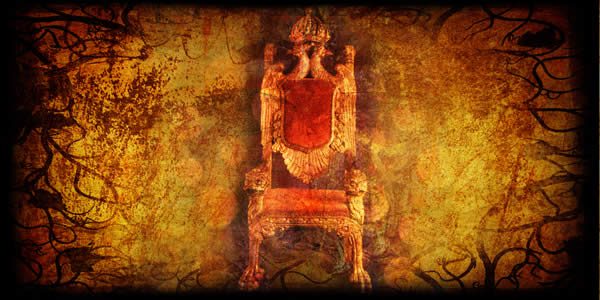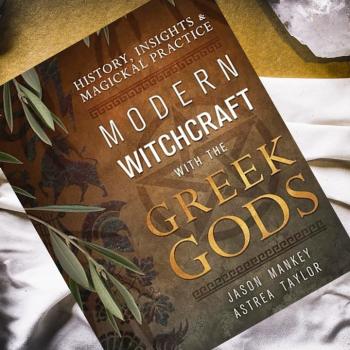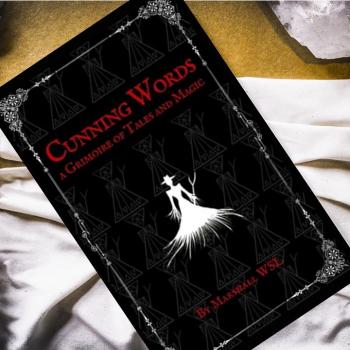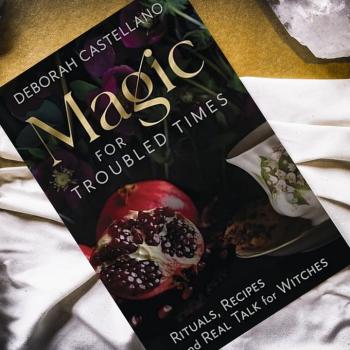There is a particular magic to mythology. I admit, I have a complicated relationship with the word magic. I’m a fairly pragmatic person, and I tend to lean toward a definition of magic as “science we can’t yet explain.” So whenever I work with myths and stories, or magical concepts, I tend to break them down and look at their function, or look at the sociology and history that created them.
“Sometimes it dispenses youth and life, at other times it possesses the power of healing…[or] inspiring strength and wisdom.”
—Emma Jung and Marie-Louise von Franz, The Grail Legend
I find the stories of the Quest for the Grail to be especially inspiring because they feel very relevant to the work of personal seeking and of building community. For example, when I look at some of the ideas surrounding magic, sovereignty, and the land, I think first of fertility magic. Do I believe that humans (particularly sovereigns) need to make love in the fields in order to bring fertility to the crops? I’d have to say no.
I also think about the physical object of the Grail. Do I think there was some magical cup or dish that healed the sick, gave immortality or wisdom, or fed people what food they liked best? Probably not.
For that matter, do I believe that there was some historical king who was wounded and who thus caused the sickening of his own land? It’s possible there was a historical king that was woven into the story of the Grail and the wounded king. For me, that isn’t the important part. What’s important for me is that I see the story of the wounded king play out with people I know in everyday life.
When the king—the sovereign, the leader—is ill, the people suffer.

Myth and Story
I believe that when we look at the story of the wounded king and the wasteland, we’re onto something real at a core level. The word “myth” sometimes bears the connotation of “a story that isn’t true.” I tend to look at myths from the perspective that these are enduring stories. They are true not because they happened exactly as told, but because they reflect human nature.
By looking back at these older stories, we can learn a lot about ourselves and our communities. There is a saying in the Grail romances. “The land and the king are one.” Or, more specifically, when the king is wounded, the land suffers and the people suffer. I don’t need to believe that there is some magical link between the fertility of the land and the health of the king to see the truth in this statement.
Think of “the land” as a metaphor. For example, think about your experiences with different organizations. Perhaps a grassroots activist group, a Pagan group, or even a corporation. Think about any group out there with a leader who is harming their group members, a leader who is stubborn and intractable, a leader who is a jerk. That leader you hate dealing with. That abusive leader. That leader that you know sexually abused their students. That leader who has many red flags for a one of the major personality disorders who is consistently engaging in harmful and destructive behavior.
When the leader is ill—when the leader is acting in unhealthy ways for themselves and their group—the group suffers. And when the group suffers, that sickness spreads out to the larger community around them.
The land and the king are one.
The Wound
A wounded sovereign is one of the reasons many groups fail. A few of my mentors used to say, “Your group cannot be any healthier than your leader,” and I’ve seen that be true much of the time. But what is the wound?
Jean Shinoda Bolen’s book Crossing to Avalon sums up the concept eloquently. She writes that “in the various Grail legends, the Fisher King’s wound is in his thigh or genitals; hence wounded sexuality, creativity, and generativity are implied.” Also, “The wasteland is a metaphor for a barren psychological landscape where creativity and generativity are absent, where nothing grows and life is meaningless and emotionally flat.” She reflects on her own experience as well as that of her clients that things like avoidance behavior and smoking “are unsatisfying efforts to feel better….fueled by the feeling of being deprived and unnourished emotionally or spiritually, which is part of the same wound. A person thus wounded seeks novelty, excitement, power, or prestige to compensate for a lack of joy or inner peace.”
I resonate with that in my own experiences; depression and the wasteland sound a lot alike. And I also see the attempts to feel better that not only fail, but often cause more problems. When we are hurt and unhappy, we act in ways that hurt ourselves and others. One of my depression coping mechanisms is avoidance, which usually digs my life into a deeper hole that’s harder to get out of.
Bolen is a psychiatrist who went on her own mid-life Grail quest and then wrote about the experience, tying together concepts from the stories with Jungian archetypes, myth, a physical pilgrimage, and her own personal experience. She observes that the wound often represents a psychological problem. “When the ego is cut off from experiencing the Self—or, put differently, when an individual lacks the inner sense of being connected to God…then a wound exists that the person experiences as gnawing, pervasive, persisting insecurity.”
Coping With Wounds
When I think about the wounds of my past and how they impacted me, what I think about is that sense of insecurity I was left with. Growing up, I was the fat kid with acne. I coped by reading fantasy novels, and then writing my own stories. I coped by shutting off my emotions so that I wouldn’t cry when I was bullied every day. I coped by being smarter than everyone else, or at least, trying to be.
Having been verbally and emotionally abused by my peers, I retreated into my own world. I tried to gain what power I could with the only means available to me. I had my brain, and I was a loner and a know-it-all. The daily bullying I endured in school left me with little true self confidence and with terrible self esteem. I was convinced that most people hated me, and the evidence of how I was treated seemed to back that up.
Whatever your own wounds are, you probably found a way to cope. However, the irony is that often the way we cope with these wounds can cause us more grief down the road. If you’ve ever been around a know-it-all, you know how annoying they can be. In my early twenties, I lamented how people didn’t like me, but eventually I came to realize that I wasn’t being rejected any more just because I was fat. I wasn’t even around the people who had bullied me in school. I came to realize that one of the core reasons I was being rejected was because I was arrogant, a know-it-all, and a socially awkward introvert.
I see this so often in the small group leaders who cause their own problems. They are egotistical, standoffish, angry, or overdramatic. Some are bullies, others desperately seek positive attention, still others seem to relish in online and in-person battles where they seek to prove someone else wrong at all costs.
The Grail and the Dark Mirror
Jean Shinoda Bolen offers that “This wound defeats the capacity to both give and receive love. Emotionally, scarcity rather than abundance prevails, and thus generosity, compassion, giving hope and helping all are constricted, and joy and growth are stifled.” Also that “In the Grail legend, [the wounded] is cut off from the spiritual communion vessel, through which healing and return of vitality would flow.”
So what heals this wound? The truth is, some wounds can be healed, and some cannot. Some of the wounded leaders out there have been harmed in the past but, through a process of self reflection and other personal work, can recognize their poor behavior and seek to correct it.
Some of the wounded have deeper issues for which there is no cure, including some of the major personality disorders like Antisocial Personality Disorder (psychopaths and sociopaths). Narcissistic Personality Disorder is another mental illness that often defies treatment. The narcissist typically acts in an arrogant, grandiose manner to disguise a core truth—they hate themselves and are convinced that everyone hates them. Unable to deal with that horrible idea, they prop up their egos by surrounding themselves with admirers, by bullying others, by always being “right.” Narcissists lack empathy for others. Wikipedia offers some basic overviews of Narcissistic Personality Disorder (and other disorders as well).
Narcissistic Personality Disorder itself is difficult to treat in part because so few narcissists will actually admit they have a problem and seek treatment. However, I find that exploring the connection between narcissism and wounding is useful because so many leaders causing their own problems have many traits of narcissists whether or not they meet the full diagnostic criteria; they display the arrogance, superiority, and attention-seeking behavior. And in many cases, that behavior covers up a deep fear of inadequacy from some experiences of their past.
I’ve looked into this dark mirror myself.
I’ve seen the places where my own horrible self esteem from those old wounds left me with coping strategies that harmed me in the long run. Feeling unloved, unwanted…hated even, I retreated into arrogance and perfectionism. I knew people wouldn’t ever like me, of course, but they liked my artwork or design work. They didn’t like me, but they liked the events I planned. They didn’t like me, but they liked what I could do. So everything I did had to be perfect.
It wasn’t until I had a narcissistic boss that I realized I did many of those things. That my own behavior was turning people off, even though so much of what I did was in an attempt to be valued, respected, and accepted!
There are many different types of wounds, and thus, many dark mirrors. However, narcissism is a crucial dark mirror especially for sovereigns—for leaders—because so many narcissists gravitate into positions of leadership. And small, volunteer-run groups are easy structures for a motivated narcissist to gain power and status.
The land and the king are one.
And so when a group leader has narcissistic behaviors, or any other harmful behaviors, the group cannot be healthier than the leader. All of us within the umbrella of Pagan communities need to look at our behaviors. What behaviors are we engaging in that are harming ourselves and our groups? Why do we engage in those behaviors?
I think we’ll often find that we’re acting out of pain from our past.
[First Published in Eternal Haunted Summer Winter 2015]
Resources:
- Emma Jung and Marie-Louise von Franz, The Grail Legend
- Jean Shinoda Bolen, M.D., Crossing to Avalon: A Woman’s Midlife Quest for the Sacred Feminine
- Jill Purce, The Mystic Spiral: Journey of the Soul
- John Matthews, The Grail: Quest for the Eternal
- Wikipedia: Pages on Narcissistic Personality Disorder and other Personality Disorders













